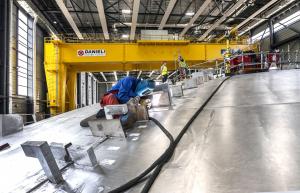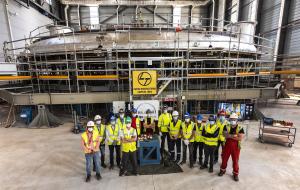First weld for the top lid
Of the four sections that make up the ITER cryostat, the top lid is the thickest, second heaviest (more than 700 tonnes) and most structurally complex. On Monday 7 June, following a traditional coconut ceremony in the Cryostat Workshop that was broadcast live to India, two welders working on opposite sides of the component's skin, produced the "first arc" of a welding campaign that is scheduled to last four to five months.
The collective knowledge and experience that the ITER Organization, ITER India, Larsen & Toubro Ltd and MAN Energy Solutions have accumulated over the past four and a half years since welding operations began on the cryostat base will be a precious asset in the current operation.
"There are some very specific challenges to the welding of this massive component," explains Anil Bhardwaj, the leader of the Cryostat & Auxiliaries Group. "It has a rather thick skin, a large circular opening at its centre and a complex arrangement of ribs underneath. Distortions due to the welding process will be a constant preoccupation and will require constant monitoring."
The cryostat top lid is made of twelve 30-degree sections that will require approximately 300 metres of deep welds (50 millimetres deep on average, but up to 280 millimetres at the flange levels) and more than 4 tonnes of filler metal.
After the cryostat base, lower cylinder and upper cylinder, the top lid will be the last section of the ITER cryostat assembled and welded in India's on-site Cryostat Workshop.



